

Micheal Case interview
By Scott Stilphen
(2007)

Although he got his start on the 'blue' side of gaming, Michael Case more than made up for it later on with his work on a pair of Oddworld sequels, among others.
Q: What’s your educational background?
Michael Case: I have a BS in Computer and Information Sciences from UC Santa Cruz.
Q: What inspired you to go into game design?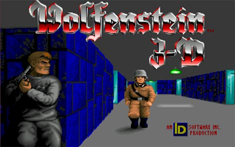
Michael Case: I loved video games.
Q: Were there any programmers or games that inspired you?
Michael Case: This was after my work on the VCS, but Wolfenstein 3-D and other John Carmack games got me into 3-D game development, and I wrote my first 3-D engine shortly thereafter.
Q: What was your first job after you graduated?
Michael Case: I worked for several companies not related to video games. Then I got a job for an “adult video game” company, Multivision, that was a startup. I had to reverse-engineer the Atari 2600 using a ROM emulator I created myself on a wire-wrapped card running off an Apple II. I created a game called Harem (I also did the graphics), and we were about to go into production when the company fell apart due to financing problems.
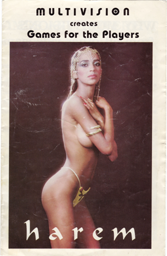 Q: All the "adult" games that were made for the VCS were somewhat hilarious. I'm not sure how anyone could get excited over stick figures!
Q: All the "adult" games that were made for the VCS were somewhat hilarious. I'm not sure how anyone could get excited over stick figures!
Michael Case: Custer's Revenge was the only adult game I knew of that made money, and it was millions. It was rather offensive though - it featured a Custer character with a giant phallus who has to dodge a volley of arrows to reach a squaw tied to a stake, who he rapes, and gets points for each thrust. Glad I didn't work on that one! At the CES show, they hired a homeless
Indian woman to protest at their booth, so that it would get written up in the paper.
Q: For your first VCS effort though, Harem is quite good. Do you still have a manual or any notes for it?
Michael Case: There never was an instruction manual, since it was never released. Any artwork I had (which consisted of me drawing on small grid graph paper) was tossed long ago. As far as the gameplay is concerned, when you are "engaged" with a woman, move your joystick to match her movement. Each time you do, you'll hear a small moan and make a point. That was probably the most "innovative" part of the
design. The idea is to get in as many thrusts (for points) as you can before the time runs out and your relationship is ruined (and you'll lose a life). Hey, I didn't design it...a bitter womanizer did! With the 1st woman, you sink into quicksand; with the 2nd (in the pit), she turns into a snake; with the 3rd, you explode with passion.
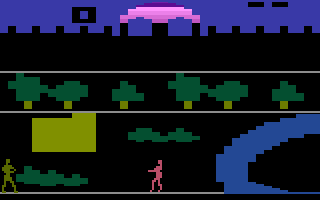
At the start, there's sniper machine gun fire from the bushes. When the shooter stops briefly to reload, you can run past. To reach the 2nd woman, you have to jump over the lake. Run until the last moment (your heel is on the edge), then press the button to jump. If you jump too soon, you fall into the water. After the woman on the island, you move to the level above, where you have to run by a fire-breathing dragon. You have to time it right to run by when he pauses blowing fire. You can only make it to the hole in the ground. Push the button to drop in, and a woman appears. If you get too greedy here, she turns into a snake and... Ow! Time leaving the pit to avoid the dragon, and run off the screen to the left. You will then be on the top level, where you have to chase a woman. Meanwhile, gargoyles appear in random positions and drop molten lava. If a gargoyle appears over you when you are "scoring points" with her (listen for the warning sound), you must push the button to release her and run. You can catch her again, and continue indefinitely, except that the gargoyles speed up each time you catch her. When you get to 69 points you get another life (you start out with 3).
Q: The flashing object at the top looks a lot like the company's logo.
Michael Case: Actually, it is the shining dome of the Harem. But it does look a lot like the ugly logo.
Q: We know of at least 6 different titles that Multivision announced for the VCS. Did you work on any others, or know of anyone else working on them?
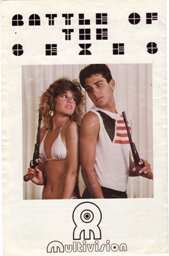 Michael Case: Wow, I had no idea that anyone would have kept track of this stuff! The only game other than Harem that I completed was
Battle of the Sexes, which involved male and female figures coming together from the top and bottom of the screen, to either shoot each other or screw each other. The owners kept the only copy. It wasn't as good. It was basically like Pong. I knocked it out in a few weeks so we could say we had two games when we approached distributors.
Michael Case: Wow, I had no idea that anyone would have kept track of this stuff! The only game other than Harem that I completed was
Battle of the Sexes, which involved male and female figures coming together from the top and bottom of the screen, to either shoot each other or screw each other. The owners kept the only copy. It wasn't as good. It was basically like Pong. I knocked it out in a few weeks so we could say we had two games when we approached distributors.
Q: What can you tell us about Multivision? We know almost nothing of the company or the people who worked there.
Michael Case: The company was started as a partnership between a wealthy dermatologist, Robert, and an erotic photographer, Eugene (Finkei), who shot a lot of Penthouse spreads and knew Bob Guccione. Eugene designed all the games, and was responsible for the advertising campaign.
I was hired by a mechanical engineer, Dick (actually, he was more of a draftsman), who had somehow convinced these guys he was a technical guru. I basically did all the work, and after results were made, I frankly told the owners that this guy was a bozo. So, after giving us both an Atari programming test (that he failed), they fired him. When Eugene fired him, they got into a shoving match, which Robert and I had to break up. They took away Dick's development
system, and he was really pissed. One night he went to Eugene's apartment and pounded on the door so hard that he left holes in it, screaming, "Give me my computer back!" The police arrived, and "interviewed" Dick, who told them he was coming back with a gun. I wouldn't have believed it, but I saw a copy of the police report. A few days later, my apartment was burglarized while I was out; I think he was in search of a copy of the game, but it had been sealed away in the
"company safe".
At this point, Robert got into a feud with Eugene, because Eugene was spending his money like water, driving around in a leased Benz with a car phone (these were rare then), and setting up expensive photo shoots with lots of hot babes. The game was completed by then, and I was frustrated that the whole thing was falling apart, but what could I do... the company lawyer tried to work out an agreement, but none could be reached. It didn't help that the lawyer was a drug fiend - he
showed up at my apartment on Sunset Blvd. one day and asked, "Hey dude, I'm loaded on Quaaludes and can't drive, can I crash at your place?"
When they gave me my last paycheck, I went to the company's bank the next morning, and waited outside before it opened. Who shows up but Eugene, about to remove all the money from the company account. He did relent and let me cash my check first, though. I was later invited for a meeting at Robert's house one night, and everyone in the company (Dick had rejoined forces with them) was there but Eugene. They were talking about killing Eugene to get control of the game, and
that's when I decided they were crazy and just gave up on the whole thing. They never were able to reach an agreement, so the game was never released.
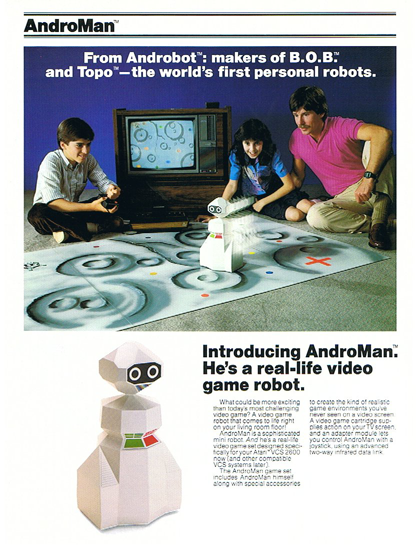
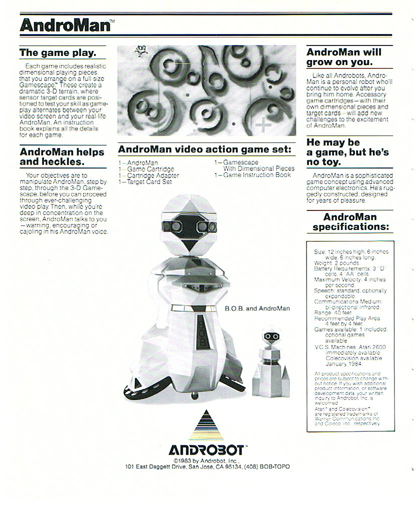
AndroMan brochure.
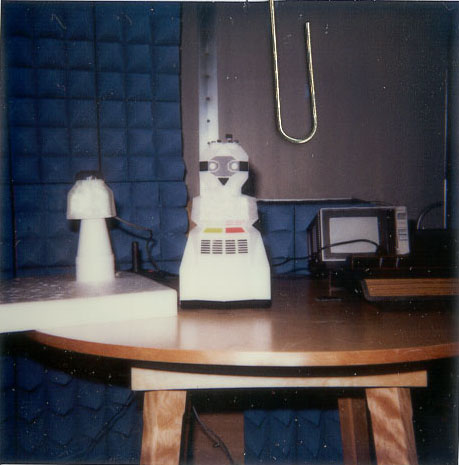
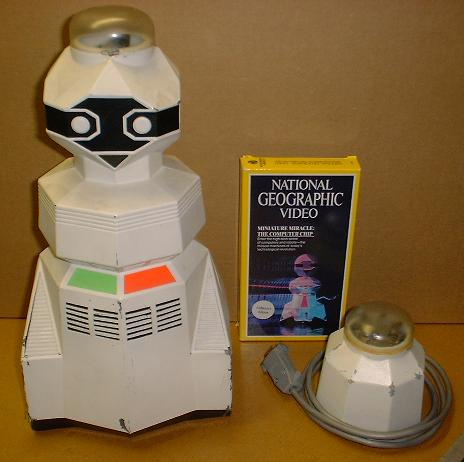
(LEFT) Photo
of AndroMan at FCC testing room within Atari; (RIGHT) Photo of AndroMan and IR
pod, courtesy of Robert L. Doerr.
Q: After Multivision, you went to work at Western Technologies. How did you hear about them?
Michael Case: A friend of a friend worked at Western, and got me an interview. I started working there in 1984. I worked at the Santa Monica office, but then they moved to Culver City, as I recall.
Q: What was the development process like? What game(s) did you work on there?
Michael Case: We worked with a manager, an artist, and a musician/sound guy. The design process was pretty loose, with everyone throwing in their ideas, and a lot of experimentation going on to see what cool effects could be achieved with the limited capabilities of the 2600.
The only VCS game I did there was AndroMan on the Moon. This was one of the games being done for the AndroMan robot. I don't remember much of the plot, but AndroMan was on the moon (I think we used the floor map shown in the advertisements). I think the enemies were supposed to be aliens. AndroMan was supposed to be harvesting minerals on the moon. He would move over bar codes on the map, which signified mines, and then the video game would show him enter the mine (the maze part), being attacked by "moon aliens" along the way. He dropped bombs to kill them. If he got hit, I think he would jerk around or make some noise, which is why the game hangs. After getting further into the mine, the corridor is shown from a first person 3-D view, and he is attacked by flying circular shaped "moon bats". He can shoot at them using the joystick to control the cursor on the screen. When he makes it to the end, he gets the resources in the mine. He then has to move on the map to return the resources to the base, and so on.
The robots weren't exactly cutting edge... just an IR connection, a scanner, and some motors. The rest was handled by software on the Atari.
Q: From what we know, 6 games were planned for the AndroMan. Besides your game, we know a version of Clue was done by David Springer. Do you recall who the other VCS programmers were, or what titles they may have been working on?
Michael Case: No, sorry! A lot of people worked there on different projects.
Q: According to the ad, the game included a “Gamescape” map with 3-D objects that you placed on it. Using the joystick, you would alternately control the robot to navigate the map and play the video game. I’m guessing all the games basically used this same premise?
Michael Case: Yes. Also, the AndroMan had a sensor that could read barcodes, so these were placed on the map so you knew where the robot was.
Q: David Springer mentioned you gave the other WT programmers a day or two long seminar on how to program it. During the seminar he mentioned a theoretical way that no one had ever done that could possibly get 32 colors on a single scan line. He got it to work and used it on his Clue game. Do you recall that seminar? I would love to find a copy of that game, but unfortunately David didn't have it.
Michael Case: Sorry, but I don't recall things with that level of detail from 35 years ago... there's been so many things I've done since then. And I don't have a copy of David's Clue game.
Q: Did you work with any graphics or sound artists? If so, do you recall who helped with what?
Michael Case: There wasn’t much art in my game, so I don’t recall the art guy, but the sound guy was a good friend of mine, Lenny Carlson, who was a musical genius.
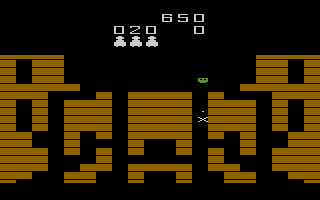
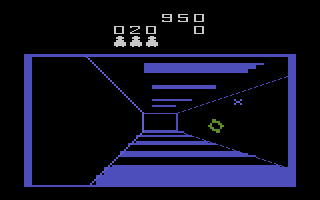
Q: What was the easiest/hardest part of designing it?
Michael Case: The game had a “3-D” segment (inspired by the Star Wars arcade game), and that was challenging on the 2600.
Q: It's interesting to note that the title screen (the "Fuji" and text below it) are nearly identical to that used in VCS Centipede, which was done by another Atari (software) sub-contractor! I haven’t done a byte-by-byte comparison of the code yet, but it looks to be exactly the same.
Michael Case: I think Atari gave us the code (in hex, not assembly source) to display the title screen.
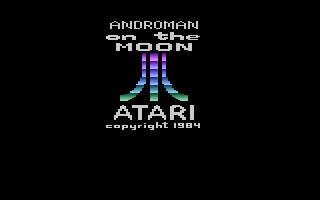
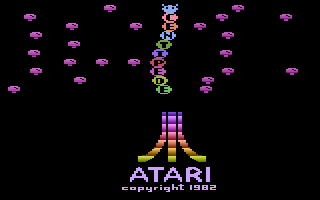
Q: Were there any features you would have liked to added to it, or any known bugs or glitches that gave you trouble (or never got resolved)?
Michael Case: The game wasn’t finished, so I would have liked to finish it, for a start…
Q: It’s a real shame that AndroMan never saw release. It sounded like a great product that was close (?) to being finished, especially in light of Nintendo’s early success of launching their NES system with a simplified version of what basically was AndroMan – R.O.B. I’m especially surprised that the project wasn’t purchased and released by someone else.
Michael Case: The entire Atari video game business collapsed within 6 months. Atari went from 2,000 to 200 employees almost overnight. I recall it was mostly because they tried to milk the 2600 for too long a time, without producing new hardware. I think the game E.T. was Atari’s real undoing. They produced millions of cartridges, expecting big sales at Christmas, but the game was horrible, and word of mouth killed sales. So, they were stuck with warehouses full of cartridges, and customers who were very unlikely to buy another game for the 2600 (Ed.: Atari's demise was sealed before E.T. was even released and was only on the market 2 weeks before the infamous crash INFO).
Q: What were some of your experiences working for WT? Any stories or anecdotes from those days that you recall?
Michael Case: I remember we had to take on a defense department contract after the AndroMan debacle. We wrote the software for a monitoring device that blew itself up after 24 hours. It was fun writing the line of code that actually blew something up!
Q: Can you describe your career, between WT and now? Have you always stayed within the video game business?
Michael Case: I did some “multimedia CD-ROMs” also, but mostly video games for almost twenty years after that. After WT, I did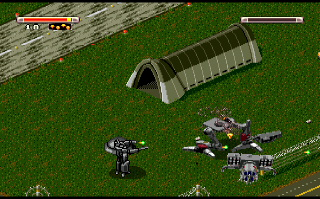 Battletech on the Sega Genesis, for Malibu Interactive. After that I had my own company, and did several PS1 to PC conversions and 1 PS1 game (IHRA Drag Racing), as well as 1 original PC game (Adrenix). In addition, I also did 2 freeware games – Santa Slayer and A Dealer in Death. Demos of the games
and freeware games are available at www.digitald.com. I also did 5 or 6 cool demos of original game titles that were never "picked up" by a publisher.
Battletech on the Sega Genesis, for Malibu Interactive. After that I had my own company, and did several PS1 to PC conversions and 1 PS1 game (IHRA Drag Racing), as well as 1 original PC game (Adrenix). In addition, I also did 2 freeware games – Santa Slayer and A Dealer in Death. Demos of the games
and freeware games are available at www.digitald.com. I also did 5 or 6 cool demos of original game titles that were never "picked up" by a publisher.
After having my own company for 7 years, and producing 8 published titles, I wasn’t making much money, and risking my own money too often. So I looked into working for other video game companies, but they all had 60 hour work weeks and low pay. Finally, I ended up programming guide software for cable boxes, which I’ve been doing for the last 4 years.
Q: Were the titles you worked on assigned, or chosen by yourself?
Michael Case: Assigned.
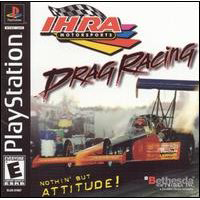 Q: Do you still own any of your games for these systems, either as a keepsake,
or to show friends or family?
Q: Do you still own any of your games for these systems, either as a keepsake,
or to show friends or family?
Michael Case: Yes, I own all the PC games and multimedia CDs I did.
Q: Are there Easter eggs in any of your titles? Do you recall any fellow co-workers that did?
Michael Case: No.
Q: Did you ever attend any industry shows, such as CES or Toy Fair
Michael Case: CES every year, until it became E3.
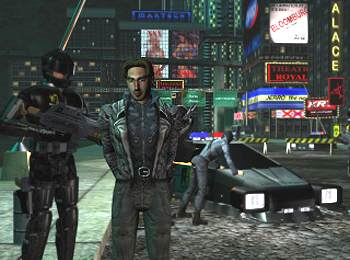
Q: Which of your titles are your favorite, and what types of games in general?
Michael Case: My favorite was an original PC game title we did called Adrenix. It’s very hard to find though (I think I have one of the few remaining copies).
Q: What are your thoughts on how the industry has evolved?
Michael Case: The business has become so hit-driven that everything is a sequel/expansion now, so it’s hard for innovation and impossible for small developers. Also, massive multiplayer games have taken over, and destroyed entire genres, such as adventure games. In general, the video game industry is one of crushed hopes, which is why it is rare to find anyone over 40 still working in the business. Nevertheless, the increasing popularity of online shareware game distribution and “casual gaming” offers some hope for small developers.
As an added bonus, Michael Case is allowing me to make both of his unreleased Atari VCS games - Androman on the Moon and Harem - freely available for everyone on the condition that the games are NOT to be sold by anyone, in any form. Enjoy!
| GAME | SYSTEM | COMPANY | STATUS |
| Harem | Atari VCS/2600 | Multivision | unreleased |
| Battle of the Sexes | Atari VCS/2600 | Multivision | unreleased |
| AndroMan on the Moon | Atari VCS/2600 | Western Technologies | unreleased |
| Battletech | Genesis | Malibu Interactive | released |
| Battle Arena Toshinden | PC | Playmates Interactive Entertainment | released |
| Zeitgeist | PC | Playmates Interactive Entertainment | released (Japan only) |
| OddWorld: Abe's Oddysee | PC | GT Interactive / Digital Dialect | released |
| OddWorld: Abe's Exoddus | PC | GT Interactive / Digital Dialect | released |
| Adrenix | PC | Playmates Interactive Entertainment / Digital Dialect | released |
| Metal Gear Solid | PC | Microsoft/Konami | released |
| IHRA Drag Racing | PS1 | Bethesda Softworks / Digital Dialect | released |
| Santa Slayer | PC | Digital Dialect | released |
| A Dealer in Death | PC | Digital Dialect | released |